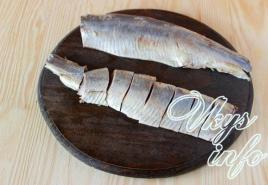How do ethers react? Where are esters used? Chemical properties of esters
Esters– functional derivatives of carboxylic acids,
in molecules in which the hydroxyl group (-OH) is replaced by an alcohol residue (-OR)
Esters of carboxylic acids – compounds with the general formula
R-COOR",where R and R" are hydrocarbon radicals.
Esters of saturated monobasic carboxylic acids have a general formula:
Physical properties:
Volatile, colorless liquids
· Poorly soluble in water
· Most often with a pleasant smell
Lighter than water
Esters are found in flowers, fruits, and berries. They determine their specific smell.
They are a component of essential oils (about 3000 e.m. are known - orange, lavender, rose, etc.)
Esters of lower carboxylic acids and lower monohydric alcohols have a pleasant smell of flowers, berries and fruits. Esters of higher monobasic acids and higher monohydric alcohols are the basis of natural waxes. For example, beeswax contains an ester of palmitic acid and myricyl alcohol (myricyl palmitate):
CH 3 (CH 2) 14 –CO–O–(CH 2) 29 CH 3
|
Aroma. Structural formula. |
Ester name |
|
Apple
|
Ethyl ether 2-methylbutanoic acid |
|
Cherry
|
Amyl formic acid ester |
|
Pear
|
Isoamyl ester of acetic acid |
|
A pineapple |
Butyric acid ethyl ester (ethyl butyrate) |
|
Banana
|
Isobutyl ester of acetic acid (y isoamyl acetate also resembles the smell of banana) |
|
Jasmine
|
Benzyl ether acetate (benzyl acetate) |
The short names of esters are based on the name of the radical (R") in the alcohol residue and the name of the RCOO group in the acid residue. For example, ethyl acetic acid CH 3 COO C 2 H 5 called ethyl acetate.
Application
· As fragrances and odor enhancers in the food and perfumery (production of soap, perfume, creams) industries;
· In the production of plastics and rubber as plasticizers.
Plasticizers – substances that are introduced into the composition of polymer materials to impart (or increase) elasticity and (or) plasticity during processing and operation.
Application in medicine
At the end of the 19th and beginning of the 20th centuries, when organic synthesis took its first steps, many esters were synthesized and tested by pharmacologists. They became the basis of such medicines as salol, validol, etc. Methyl salicylate was widely used as a local irritant and analgesic, which has now been practically replaced by more effective drugs.
Preparation of esters
Esters can be obtained by reacting carboxylic acids with alcohols ( esterification reaction). The catalysts are mineral acids.
Video “Preparation of ethyl acetyl ether”
Video “Preparation of boronethyl ether”
The esterification reaction under acid catalysis is reversible. The reverse process - the cleavage of an ester under the action of water to form a carboxylic acid and alcohol - is called ester hydrolysis.
RCOOR" + H2O (H+)↔ RCOOH + R"OH
Hydrolysis in the presence of alkali is irreversible (since the resulting negatively charged carboxylate anion RCOO does not react with the nucleophilic reagent - alcohol).
This reaction is called saponification of esters(by analogy with alkaline hydrolysis of ester bonds in fats when producing soap).
Esters can be considered as derivatives of acids in which the hydrogen atom in the carboxyl group is replaced by a hydrocarbon radical:
Nomenclature.
Esters are named after the acids and alcohols whose residues participate in their formation, for example H-CO-O-CH3 - methyl formate, or methyl ester of formic acid; - ethyl acetate, or ethyl ester of acetic acid.
Methods of obtaining.
1. Interaction of alcohols and acids (esterification reaction):
2. Interaction of acid chlorides and alcohols (or alkali metal alcoholates):
Physical properties.
Esters of lower acids and alcohols are liquids lighter than water, with a pleasant odor. Only esters with the smallest number of carbon atoms are soluble in water. Esters are highly soluble in alcohol and distyl ether.
Chemical properties.
1. Hydrolysis of esters is the most important reaction of this group of substances. Hydrolysis under the influence of water is a reversible reaction. To shift the equilibrium to the right, alkalis are used:

2. Reduction of esters with hydrogen leads to the formation of two alcohols:
3. Under the influence of ammonia, esters are converted into acid amides:
Fats. Fats are mixtures of esters formed by the trihydric alcohol glycerol and higher fatty acids. General formula of fats:

where R are radicals of higher fatty acids.
Most often the composition of fats includes saturated palmitic and stearic acids and unsaturated oleic and linoleic acids.
Obtaining fats.
Currently, only obtaining fats from natural sources of animal or plant origin is of practical importance.
Physical properties.
Fats formed by saturated acids are solids, and unsaturated fats are liquid. All are very poorly soluble in water, highly soluble in diethyl ether.
Chemical properties.
1. Hydrolysis, or saponification of fats occurs under the influence of water (reversible) or alkalis (irreversible):

Alkaline hydrolysis produces salts of higher fatty acids, called soaps.
2. Hydrogenation of fats is the process of adding hydrogen to the residues of unsaturated acids that make up fats. In this case, the residues of unsaturated acids turn into residues of saturated acids, and fats turn from liquid to solid.
Of the most important nutrients - proteins, fats and carbohydrates - fats have the greatest energy reserve.
a class of compounds based on mineral (inorganic) or organic carboxylic acids, in which the hydrogen atom in the HO group is replaced by an organic group R . The adjective “complex” in the name of esters helps to distinguish them from compounds called ethers.If the starting acid is polybasic, then the formation of either full esters all HO groups are substituted, or acid esters partial substitution is possible. For monobasic acids, only full esters are possible (Fig. 1).
Rice. 1. EXAMPLES OF ESTERS based on inorganic and carboxylic acid
Nomenclature of esters. The name is created as follows: first the group is indicated R , attached to the acid, then the name of the acid with the suffix “at” (as in the names of inorganic salts: carbon at sodium, nitrate at chromium). Examples in Fig.2
If you use trivial ( cm. TRIVIAL NAMES OF SUBSTANCES) is the name of the starting acid, then the name of the compound includes the word “ester”, for example, C 3 H 7 COOC 5 H 11 amyl ester of butyric acid.
Classification and composition of esters. Among the studied and widely used esters, the majority are compounds derived from carboxylic acids. Esters based on mineral (inorganic) acids are not so diverse, because the class of mineral acids is less numerous than carboxylic acids (the variety of compounds is one of the distinguishing features organic chemistry).When the number of C atoms in the original carboxylic acid and alcohol does not exceed 68, the corresponding esters are colorless oily liquids, most often with a fruity odor. They form a group of fruit esters. If an aromatic alcohol (containing an aromatic nucleus) is involved in the formation of an ester, then such compounds, as a rule, have a floral rather than a fruity odor. All compounds in this group are practically insoluble in water, but easily soluble in most organic solvents. These compounds are interesting because of their wide range of pleasant aromas (Table 1); some of them were first isolated from plants and later synthesized artificially.
| Table 1. SOME ESTERS, having a fruity or floral aroma (fragments of the original alcohols in the compound formula and in the name are highlighted in bold) | ||
| Ester Formula | Name | Aroma |
| CH 3 COO C 4 H 9 | Butyl acetate | pear |
| C 3 H 7 COO CH 3 | Methyl Butyric acid ester | apple |
| C 3 H 7 COO C 2 H 5 | Ethyl Butyric acid ester | pineapple |
| C 4 H 9 COO C 2 H 5 | Ethyl | crimson |
| C 4 H 9 COO C 5 H 11 | Isoamil isovaleric acid ester | banana |
| CH 3 COO CH 2 C 6 H 5 | Benzyl acetate | jasmine |
| C 6 H 5 COO CH 2 C 6 H 5 | Benzyl benzoate | floral |
The third group is fats. Unlike the previous two groups based on monohydric alcohols
ROH , all fats are esters of glycerol alcohol HOCH 2 CH(OH)CH 2 OH. Carboxylic acids that make up fats usually have a hydrocarbon chain with 919 carbon atoms. Animal fats (cow butter, lamb, lard) plastic, fusible substances. Vegetable fats (olive, cottonseed, sunflower oil) viscous liquids. Animal fats mainly consist of a mixture of glycerides of stearic and palmitic acid (Fig. 3A, B). Vegetable oils contain glycerides of acids with a slightly shorter carbon chain length: lauric C 11 H 23 COOH and myristic C 13 H 27 COOH. (like stearic and palmitic these are saturated acids). Such oils can be stored in air for a long time without changing their consistency, and therefore are called non-drying. In contrast, flaxseed oil contains unsaturated linoleic acid glyceride (Figure 3B). When applied in a thin layer to the surface, such oil dries under the influence of atmospheric oxygen during polymerization along double bonds, and an elastic film is formed that is insoluble in water and organic solvents. Natural drying oil is made from linseed oil.
Rice. 3. GLYCERIDES OF STEARIC AND PALMITIC ACID (A AND B) components of animal fat. Linoleic acid glyceride (B) component of linseed oil.
Esters of mineral acids (alkyl sulfates, alkyl borates containing fragments of lower alcohols C 18) oily liquids, esters of higher alcohols (starting from C 9) solid compounds.
Chemical properties of esters. Most characteristic of esters of carboxylic acids is the hydrolytic (under the influence of water) cleavage of the ester bond; in a neutral environment it proceeds slowly and noticeably accelerates in the presence of acids or bases, because H + and HO ions catalyze this process (Fig. 4A), with hydroxyl ions acting more efficiently. Hydrolysis in the presence of alkalis is called saponification. If you take an amount of alkali sufficient to neutralize all the acid formed, then complete saponification of the ester occurs. This process is carried out on an industrial scale, and glycerin and higher carboxylic acids (C 1519) are obtained in the form of alkali metal salts, which are soap (Fig. 4B). Fragments of unsaturated acids contained in vegetable oils, like any unsaturated compounds, can be hydrogenated, hydrogen attaches to double bonds and compounds similar to animal fats are formed (Fig. 4B). Using this method, solid fats are produced industrially based on sunflower, soybean or corn oil. Margarine is made from hydrogenation products of vegetable oils mixed with natural animal fats and various food additives.The main method of synthesis is the interaction of a carboxylic acid and an alcohol, catalyzed by the acid and accompanied by the release of water. This reaction is the opposite of that shown in Fig. 3A. In order for the process to proceed in the desired direction (ester synthesis), water is distilled (distilled) from the reaction mixture. Through special studies using labeled atoms, it was possible to establish that during the synthesis process, the O atom, which is part of the resulting water, is detached from the acid (marked with a red dotted frame), and not from the alcohol (the unrealized option is highlighted with a blue dotted frame).
Using the same scheme, esters of inorganic acids, for example, nitroglycerin, are obtained (Fig. 5B). Instead of acids, acid chlorides can be used; the method is applicable for both carboxylic (Fig. 5C) and inorganic acids (Fig. 5D).
Interaction of carboxylic acid salts with alkyl halides
RCl also leads to esters (Fig. 5D), the reaction is convenient in that it is irreversible; the released inorganic salt is immediately removed from the organic reaction medium in the form of a precipitate.Use of esters. Ethyl formate HCOOC 2 H 5 and ethyl acetate H 3 COOC 2 H 5 are used as solvents for cellulose varnishes (based on nitrocellulose and cellulose acetate).Esters based on lower alcohols and acids (Table 1) are used in the food industry to create fruit essences, and esters based on aromatic alcohols in the perfume industry.
Polishes, lubricants, impregnating compositions for paper (waxed paper) and leather are made from waxes; they are also included in cosmetic creams and medicinal ointments.
Fats, together with carbohydrates and proteins, make up a set of foods necessary for nutrition; they are part of all plant and animal cells; in addition, when they accumulate in the body, they play the role of an energy reserve. Due to its low thermal conductivity, the fat layer protects animals (especially sea whales or walruses) well from hypothermia.
Animal and vegetable fats are raw materials for the production of higher carboxylic acids, detergents and glycerol (Fig. 4), used in the cosmetics industry and as a component of various lubricants.
Nitroglycerin (Fig. 4) is a well-known drug and explosive, the basis of dynamite.
Drying oils are made from vegetable oils (Fig. 3), which form the basis of oil paints.
Esters of sulfuric acid (Fig. 2) are used in organic synthesis as alkylating (introducing an alkyl group into a compound) reagents, and esters of phosphoric acid (Fig. 5) are used as insecticides, as well as additives to lubricating oils.
Mikhail Levitsky
LITERATURE Kartsova A.A. Conquest of matter. Organic chemistry. Khimizdat Publishing House, 1999Pustovalova L.M. Organic chemistry. Phoenix, 2003
To the carbon radical. There are mono-, di- and polyesters. For monobasic acids there are monoesters, di- and polybasic acids - full and acid esters. The name of an ester consists of the name of the acid and alcohol involved in its formation. Trivial or historical nomenclature is often used to name ethers. According to the IUPAC nomenclature, the names of esters are formed as follows: take the name of the alcohol as a radical, add the name of the acid as a hydrocarbon and the ending -oate. For example, the structural formulas of ethers (isomers and metamers) corresponding to the molecular formula C4H802 are called according to different nomenclatures as follows: propyl formate (propyl methanoate), isopropyl formate (isopropyl methanoate), ethyl acetate (ethyl ethanoate), melpropionate (methyl propanoate).
Preparation of esters. These compounds are widely distributed in nature. Thus, esters of low molecular weight and medium carboxylic acids are part of the essential oils of many plants (for example, acetic isoamyl ester, or “pear essence”, which is part of pears and many flowers), and esters of glycerol and higher fatty acids are the chemical basis of all fats and oils . Some esters are produced synthetically.
The esterification reaction occurs as a result of the interaction of carboxylic (and mineral) acids with alcohols. A strong mineral acid acts as a catalyst (H2S04 is most often used). A catalyst activates a molecule
Esterification also depends on which carbon atom the OH group is connected to (primary, secondary or tertiary), on the chemical nature of the acid and alcohol, as well as the structure of the hydrocarbon chain that is linked to the carboxyl.
Hydrolysis of esters. (saponification) of esters is the reverse reaction of esterification. It goes by slowly. If you add a mixture of mineral acids or alkalis to the reaction mixture, its speed increases. Saponification with alkalis occurs a thousand times faster than with acids. Esters hydrolyze in an alkaline environment, and ethers hydrolyze in an acidic environment.
When esters with alcohols are heated in the presence of sulfate acid or alcoholates (in an alkaline medium), an exchange of alkoxy groups occurs. In this case, a new ether is formed, and the alcohol, which was previously included in the form of residues in the composition of the ether molecule, is returned to the reaction medium.
Esters: reduction reaction. The reducing agents most often are lithium and sodium aluminum hydrates in boiling alcohol. The high resistance of esters to various oxidizing agents is used in chemical synthesis or analysis to protect alcohol and phenolic groups.
Esters: main representatives. Ethyl ethanoate (ethyl acetate ether) is obtained through the esterification reaction of acetate acid and ethanol (catalyst Ethyl ethanoate is used as a solvent for cellulose nitrate in the production of smokeless powder, photographic and film films, and a component of fruit essences for the food industry.
Isoamyl ethanoate (acetic isoamyl ether, “pear essence”) is highly soluble in ethanol and diethyl ether. Obtained by esterification of acetate acid and isoamyl alcohol. Isoamyl methyl butanoate is used as an aromatic component in perfumery and as a solvent.
Isoamyl isovalerate (“apple” essence, isovaleric isoamyl ester) is obtained by the esterification reaction of isovaleric acid and isoamyl alcohol. This ester is used as fruit essence in the food industry.
Esters are commonly called compounds obtained by esterification reaction from carboxylic acids. In this case, the OH- from the carboxyl group is replaced by an alkoxy radical. As a result, esters are formed, the formula of which is generally written as R-COO-R."
Structure of the ester group
The polarity of chemical bonds in ester molecules is similar to the polarity of bonds in carboxylic acids. The main difference is the absence of a mobile hydrogen atom, in place of which a hydrocarbon residue is located. At the same time, the electrophilic center is located on the carbon atom of the ester group. But the carbon atom of the alkyl group connected to it is also positively polarized.
Electrophilicity, and therefore the chemical properties of esters, are determined by the structure of the hydrocarbon residue that takes the place of the H atom in the carboxyl group. If a hydrocarbon radical forms a conjugated system with an oxygen atom, then the reactivity increases noticeably. This happens, for example, in acrylic and vinyl esters.
Physical properties
Most esters are liquids or crystalline substances with a pleasant aroma. Their boiling point is usually lower than that of carboxylic acids of similar molecular weights. This confirms the decrease in intermolecular interactions, and this, in turn, is explained by the absence of hydrogen bonds between neighboring molecules.
However, just like the chemical properties of esters, the physical properties depend on the structural features of the molecule. More precisely, on the type of alcohol and carboxylic acid from which it is formed. On this basis, esters are divided into three main groups:
- Fruity esters. They are formed from lower carboxylic acids and the same monohydric alcohols. Liquids with characteristic pleasant floral and fruity odors.
- Waxes. They are derivatives of higher (number of carbon atoms from 15 to 30) acids and alcohols, each having one functional group. These are plastic substances that soften easily in your hands. The main component of beeswax is myricyl palmitate C 15 H 31 COOC 31 H 63, and the Chinese one is cerotic acid ester C 25 H 51 COOC 26 H 53. They are insoluble in water, but soluble in chloroform and benzene.
- Fats. Formed from glycerol and medium and higher carboxylic acids. Animal fats are usually solid under normal conditions, but melt easily when the temperature rises (butter, lard, etc.). Vegetable fats are characterized by a liquid state (linseed, olive, soybean oils). The fundamental difference in the structure of these two groups, which affects the differences in the physical and chemical properties of esters, is the presence or absence of multiple bonds in the acid residue. Animal fats are glycerides of unsaturated carboxylic acids, and vegetable fats are saturated acids.
Chemical properties
Esters react with nucleophiles, resulting in substitution of the alkoxy group and acylation (or alkylation) of the nucleophilic agent. If the structural formula of an ester contains an α-hydrogen atom, then ester condensation is possible.
1. Hydrolysis. Acid and alkaline hydrolysis is possible, which is the reverse reaction of esterification. In the first case, hydrolysis is reversible, and the acid acts as a catalyst:
R-COO-R" + H 2 O<―>R-COO-H + R"-OH
Basic hydrolysis is irreversible and is usually called saponification, and sodium and potassium salts of fatty carboxylic acids are called soaps:
R-COO-R" + NaOH ―> R-COO-Na + R"-OΗ

2. Ammonolysis. Ammonia can act as a nucleophilic agent:
R-COO-R" + NH 3 ―> R-СО-NH 2 + R"-OH
3. Transesterification. This chemical property of esters can also be attributed to the methods of their preparation. Under the influence of alcohols in the presence of H + or OH -, it is possible to replace the hydrocarbon radical connected to oxygen:
R-COO-R" + R""-OH ―> R-COO-R"" + R"-OH
4. Reduction with hydrogen leads to the formation of molecules of two different alcohols:
R-СО-OR" + LiAlH 4 ―> R-СΗ 2 -ОХ + R"OH
5. Combustion is another typical reaction for esters:
2CΗ 3 -COO-CΗ 3 + 7O 2 = 6CO 2 + 6H 2 O
6. Hydrogenation. If there are multiple bonds in the hydrocarbon chain of an ether molecule, then the addition of hydrogen molecules is possible along them, which occurs in the presence of platinum or other catalysts. For example, it is possible to obtain solid hydrogenated fats (margarine) from oils.

Application of esters
Esters and their derivatives are used in various industries. Many of them dissolve various organic compounds well and are used in perfumery and the food industry, for the production of polymers and polyester fibers.
Ethyl acetate. Used as a solvent for nitrocellulose, cellulose acetate and other polymers, for the manufacture and dissolution of varnishes. Due to its pleasant aroma, it is used in the food and perfume industries.
Butyl acetate. Also used as a solvent, but also polyester resins.
Vinyl acetate (CH 3 -COO-CH=CH 2). It is used as a polymer base necessary in the preparation of glue, varnishes, synthetic fibers and films.
Malonic ether. Due to its special chemical properties, this ester is widely used in chemical synthesis for the production of carboxylic acids, heterocyclic compounds, and aminocarboxylic acids.

Phthalates. Esters of phthalic acid are used as plasticizing additives for polymers and synthetic rubbers, and dioctyl phthalate is also used as a repellent.
Methyl acrylate and methyl methacrylate. They easily polymerize to form sheets of organic glass that are resistant to various influences.












